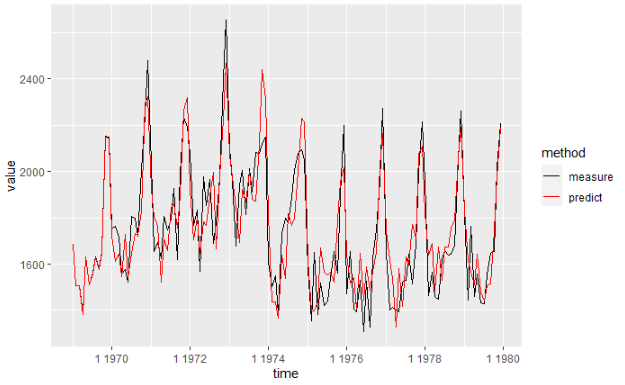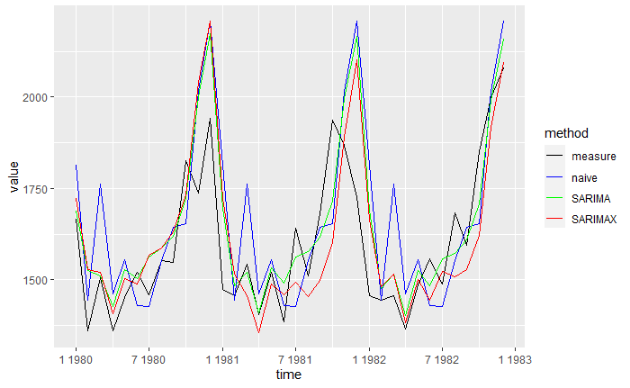Introduction
時系列モデリング手法の1つであるSARIMAXをRで実装する方法についてのメモ.
パッケージインストールとインポート
library(xts) # xts型の提供
library(forecast) # 時系列モデルの作成と予測
library(ggfortify) # グラフ描画
library(tidyverse) # データ操作
library(tseries) # 正規性の検定
データ操作
今回は,Rにデフォルトで用意されているSeatbeltsデータを使用.
- データ説明:英国における1969年~1984年の自動車運転手の死傷者数.期間中の1983年1月31日にシートベルトの着用が義務づけられた.
- 変数説明
- DriversKilled:自動車運転手の死亡者数
- drivers:死傷者数
- front:前座席の同乗者の死傷者数
- rear:後部座席の同乗者の死傷者数
- kms:走行距離
- PetrolPrice:ガソリン価格
- VanKilled:バン(軽貨物車)運転者の死亡数
- law:シートベルトの着用義務
dataset = as.xts(Seatbelts)
dim(dataset)
head(dataset)
Out:
[1] 192 8
DriversKilled drivers front rear kms PetrolPrice VanKilled law
1 1969 107 1687 867 269 9059 0.1029718 12 0
2 1969 97 1508 825 265 7685 0.1023630 6 0
3 1969 102 1507 806 319 9963 0.1020625 12 0
4 1969 87 1385 814 407 10955 0.1008733 8 0
5 1969 119 1632 991 454 11823 0.1010197 10 0
6 1969 106 1511 945 427 12391 0.1005812 13 0
データ分割
今回はdriversを自身の過去の値から予測する.説明変数(外生変数)としてkmsとPetroPriceを加える.
シートベルト着用義務の法律が施行される前の期間で訓練データとテストデータを作成する.
dataset_law0 = dataset['::1982-12', c('drivers', 'kms','PetrolPrice')]
train = dataset_law0['::1979-12']
test = dataset_law0['1980-01::']
y_train = train[,'drivers']
X_train = train[,c('kms','PetrolPrice')]
y_test = test[,'drivers']
X_test = test[,c('kms','PetrolPrice')]
データの特徴把握
まずは全変数の時系列グラフを確認
autoplot(train)
続いて時系列データ特有の特徴を確認
ggtsdisplay(y_train, main = 'drivers')
- 上:データの時系列グラフ
- 左下:自己相関コレログラム;Lag=12で相関が強くなっているため,12ヶ月の周期性があると見て取る.
- 右下:偏自己相関コレログラム;Lag=1で相関が強くなっているため,1時刻前の値が強く影響していると見て取る.
Out:

先ほどとは別の方法でデータの特徴を把握する.
STL分解をすることでデータを以下のように3つの要素に分解する.
$$
元データ=季節性+トレンド+残差
$$
- seasonalグラフ:似た波形が繰り返し出現しているため,季節性ありと判断できる.
- trendグラフ:一部区間で上昇トレンドが見て取れる.
- remainderグラフ:値が極端に高いところなどは外れ値となるが,今回の例では外れ値は無いと判断する.
plot(stl(x=y_train, s.window='periodic'), main='driver')
モデル作成
SARIMAXモデルは以下のような要素から成るモデル.
$$
SARIMAX = Seasonal(季節成分)+AR(自己回帰)モデル+Integrated(和分)+MA(移動平均)モデル+eXgenous(外因性)
$$
SARIMAXモデルを構築する.
auto.arima()でパラメータを最適化したモデルを自動選択できる.
選択されたパラメータはARIMA(p,d,q)(P,D,Q)[s]の形で表示される.
- p,(P):ARの次数(季節成分に対するARの次数)
- d,(D):和分の階数(季節成分に対する和分の階数)
- q,(Q):MAの次数(季節成分に対するMAの次数)
- s:季節成分の周期
一部引数の詳細
auto.arima(
y, # 学習する時系列データ
max.p = 5, # 探索する次数p(ARモデル)の最大値
max.q = 5, # 探索する次数q(MAモデル)の最大値
max.P = 2, # 探索する次数P(季節成分のARモデル)の最大値
max.Q = 2, # 探索する次数Q(季節成分のMAモデル)の最大値
max.order = 5, #(p+q+P+Q)の合計値.
seasonal = TRUE, # TRUE:SARIMAモデル; FALSE:ARIMAモデル
ic = c("aicc", "aic", "bic"), # モデル選択に使用される情報量基準
stepwise = TRUE, # True:ステップワイズで探索; False:全探索
trace = FALSE, # Trueの場合探索したモデルの情報がリスト表示される
approximation = (length(x) > 150 | frequency(x) > 12), # 指定した条件に該当する場合近似解を用いる.近似解を使用しない場合はFALSEにする.
xreg = NULL, # 外生変数を指定
parallel = FALSE, # TRUE:並列処理を行う
num.cores = 2, # 並列処理を行う際のコア数の指定
...
)
model_sarimax = auto.arima(y_train, max.order=14, ic='aic', ,stepwise=F, parallel=T, num.cores=4, xreg=X_train)
model_sarimax
Out:
Series: y_train
Regression with ARIMA(3,0,1)(0,1,1)[12] errors
Coefficients:
ar1 ar2 ar3 ma1 sma1 kms PetrolPrice
-0.5666 0.5975 0.4085 0.9443 -0.8597 -0.0027 -7755.019
s.e. 0.0988 0.0905 0.0885 0.0832 0.1723 0.0197 2259.103
sigma^2 estimated as 16913: log likelihood=-759.8
AIC=1535.6 AICc=1536.9 BIC=1557.9
ちなみに上記のモデルをArima()を使って構築すると以下のようになる.
model_sarimax2 = arima(y_train, order=c(3,0,1), seasonal=c(0,1,1), xreg=X_train)
model_sarimax2
Out:
Call:
arima(x = y_train, order = c(3, 0, 1), seasonal = c(0, 1, 1), xreg = X_train)
Coefficients:
ar1 ar2 ar3 ma1 sma1 kms PetrolPrice
-0.5666 0.5975 0.4085 0.9443 -0.8597 -0.0027 -7755.019
s.e. 0.0988 0.0905 0.0885 0.0832 0.1723 0.0197 2259.103
sigma^2 estimated as 15926: log likelihood = -759.8, aic = 1535.6
モデル評価
残差チェック
checkresidualsで残差に自己相関があるかのチェックを行う.
帰無仮説は「自己相関がない」なので,今回の例では,p-value=0.09であるため,有意水準5%では自己相関があるとは言えないことになる.よってチェックはクリア.
同時に出力されるグラフに関する説明は以下の通り.
- 上:残差のの時系列グラフ;周期性が見られるとそのモデルは信頼性に欠ける
- 左下:残差の自己相関コレログラム;自己相関があるとそのモデルは信頼性に欠ける.
- 右下:残差のヒストグラム;正規分布から逸脱しているとそのモデルは信頼性に欠ける.
checkresiduals(model_sarimax)
Out:
Ljung-Box test
data: Residuals from Regression with ARIMA(3,0,1)(0,1,1)[12] errors
Q* = 25.124, df = 17, p-value = 0.09198
Model df: 7. Total lags used: 24
jarque.bera.test()で残差の正規性の検定を行う.
帰無仮説は「正規分布に従う」なので,今回の例ではp-value=0.6125であるため,有意水準5%では正規分布に従わないとは言えないことになる.よってチェックはクリア.
jarque.bera.test(resid(model_sarimax))
Out:
Jarque Bera Test
data: resid(model_sarimax)
X-squared = 0.98046, df = 2, p-value = 0.6125
予測
今回は未来のの外生変数の値が分かっている前提で予測する.
pred_sarimax = forecast(model_sarimax, xreg=X_test, h=length(y_test))
autoplot(pred_sarimax, y_test)
精度評価指標の算出
accuracy(pred_sarimax, y_test)
Out:
ME RMSE MAE MPE MAPE MASE ACF1
Training set -3.552711 120.3265 95.78231 -0.6330721 5.553774 0.6443118 -0.001547839
Test set -17.228042 147.2290 110.48983 -1.3294291 6.744713 0.7432468 NA
訓練データの実測値と予測値を可視化
test_meas_pred = data.frame(time=index(y_train), measure=as.vector(y_train), predict=model_sarimax$fitted)
test_meas_pred = gather(test_meas_pred, key='method', value='value', -time)
ggplot() +
geom_line(data=test_meas_pred, aes(x=time, y=value, colour=method)) +
scale_color_manual(values=c('black', 'red'))
テストデータの実測値と予測値を可視化
test_meas_pred = data.frame(time=index(y_test), measure=as.vector(y_test), predict=pred_sarimax$mean)
test_meas_pred = gather(test_meas_pred, key='method', value='value', -time)
ggplot() +
geom_line(data=test_meas_pred, aes(x=time, y=value, colour=method)) +
scale_color_manual(values=c('black', 'red'))
モデル比較
モデル単体では精度の良し悪しわ分からないので,今回は以下の3つのモデルで精度を比較する.
- SARIMAXモデル:先ほど作成したもの.
- SARIMAモデル:外生変数を含まないもの.
- ナイーブ予測:モデルを使わないシンプルな予測.今回は1周期前の値をそのまま予測値とする.
SARIMAモデル
model_sarima = auto.arima(y_train, max.order=10, ic='aic', ,stepwise=F, parallel=T, num.cores=4)
model_sarima
Out:
Series: y_train
ARIMA(1,1,4)(0,1,1)[12]
Coefficients:
ar1 ma1 ma2 ma3 ma4 sma1
-0.7517 0.2348 -0.4050 -0.0433 -0.3153 -0.8690
s.e. 0.1194 0.1455 0.1136 0.0932 0.1028 0.1932
sigma^2 estimated as 17777: log likelihood=-757.71
AIC=1529.43 AICc=1530.43 BIC=1548.88
pred_sarima = forecast(model_sarima, h=length(y_test))
ナイーブ予測
pred_naive = snaive(y_train, h=length(y_test))
テストデータで実測値と各モデルの予測値を比較
test_meas_pred3 = data.frame(time=index(y_test), measure=as.vector(y_test), SARIMAX=pred_sarimax$mean, SARIMA=pred_sarima$mean, naive=pred_naive$mean)
test_meas_pred3 = gather(test_meas_pred3, key='method', value='value', -time)
ggplot() +
geom_line(data=test_meas_pred3, aes(x=time, y=value, colour=method)) +
scale_color_manual(values=c('black', 'blue', 'green', 'red'))
RMSEを比較したところ,テストデータにおいてはSARIMAモデルが最良の結果となった.
rmse_df = rbind(
t(as.data.frame(accuracy(pred_sarimax, y_test)[,'RMSE'])),
t(as.data.frame(accuracy(pred_sarima, y_test)[,'RMSE'])),
t(as.data.frame(accuracy(pred_naive, y_test)[,'RMSE']))
)
rownames(rmse_df) = c('SARIMAX', 'SARIMA', 'naive')
rmse_df
Out:
Training set Test set
SARIMAX 120.3265 147.2290
SARIMA 123.3607 133.0183
naive 196.8749 182.3017
Conclusion
今回はSARIMAXモデルの構築から精度の評価まで実装してみた.
時系列モデリング手法はVARや状態空間モデル,ディープラーニング等まだまだ気になる手法があるので,それらも随時投稿していこうと思う.
code
# パッケージインストールとインポート
library(xts) # xts型の提供
library(forecast) # 時系列モデルの作成と予測
library(ggfortify) # グラフ描画
library(tidyverse) # データ操作
library(tseries) # 正規性の検定
# データ操作
dataset = as.xts(Seatbelts)
dim(dataset)
head(dataset)
## データ分割
dataset_law0 = dataset['::1982-12', c('drivers', 'kms','PetrolPrice')]
train = dataset_law0['::1979-12']
test = dataset_law0['1980-01::']
y_train = train[,'drivers']
X_train = train[,c('kms','PetrolPrice')]
y_test = test[,'drivers']
X_test = test[,c('kms','PetrolPrice')]
## データの特徴把握
autoplot(train)
ggtsdisplay(y_train, main = 'drivers')
plot(stl(x=y_train, s.window='periodic'), main='driver')
# モデル作成
model_sarimax = auto.arima(y_train, max.order=14, ic='aic', ,stepwise=F, parallel=T, num.cores=4, xreg=X_train)
model_sarimax
model_sarimax2 = arima(y_train, order=c(3,0,1), seasonal=c(0,1,1), xreg=X_train)
model_sarimax2
# モデル評価
## 残差チェック
checkresiduals(model_sarimax)
jarque.bera.test(resid(model_sarimax))
## 予測
pred_sarimax = forecast(model_sarimax, xreg=X_test, h=length(y_test))
autoplot(pred_sarimax, y_test)
accuracy(pred_sarimax, y_test)
test_meas_pred = data.frame(time=index(y_train), measure=as.vector(y_train), predict=model_sarimax$fitted)
test_meas_pred = gather(test_meas_pred, key='method', value='value', -time)
ggplot() +
geom_line(data=test_meas_pred, aes(x=time, y=value, colour=method)) +
scale_color_manual(values=c('black', 'red'))
test_meas_pred = data.frame(time=index(y_test), measure=as.vector(y_test), predict=pred_sarimax$mean)
test_meas_pred = gather(test_meas_pred, key='method', value='value', -time)
ggplot() +
geom_line(data=test_meas_pred, aes(x=time, y=value, colour=method)) +
scale_color_manual(values=c('black', 'red'))
# モデル比較
model_sarima = auto.arima(y_train, max.order=10, ic='aic', ,stepwise=F, parallel=T, num.cores=4)
model_sarima
pred_sarima = forecast(model_sarima, h=length(y_test))
pred_naive = snaive(y_train, h=length(y_test))
test_meas_pred3 = data.frame(time=index(y_test), measure=as.vector(y_test), SARIMAX=pred_sarimax$mean, SARIMA=pred_sarima$mean, naive=pred_naive$mean)
test_meas_pred3 = gather(test_meas_pred3, key='method', value='value', -time)
ggplot() +
geom_line(data=test_meas_pred3, aes(x=time, y=value, colour=method)) +
scale_color_manual(values=c('black', 'blue', 'green', 'red'))
rmse_df = rbind(
t(as.data.frame(accuracy(pred_sarimax, y_test)[,'RMSE'])),
t(as.data.frame(accuracy(pred_sarima, y_test)[,'RMSE'])),
t(as.data.frame(accuracy(pred_naive, y_test)[,'RMSE']))
)
rownames(rmse_df) = c('SARIMAX', 'SARIMA', 'naive')
rmse_df






